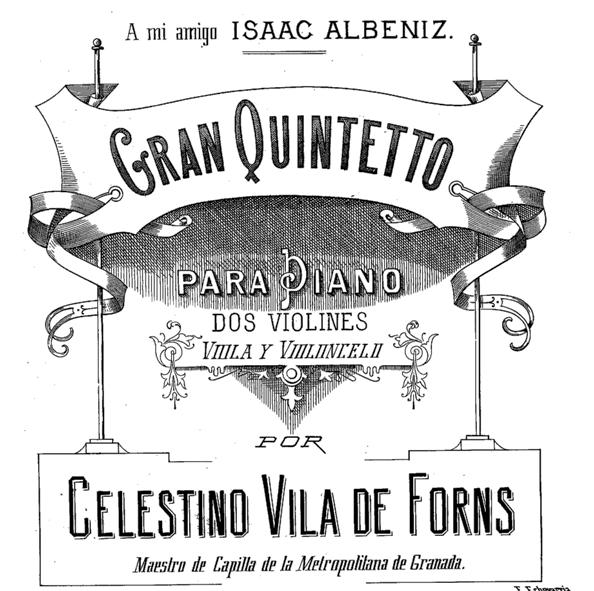Presents
Celestino Vila de Forns
Piano Quintet in A Major
 Celestino de Vila Forns (1830-1915) was born in the Catalonian town of Bellpuig.
His ecclesiastical and musical studies took place in the seminary at the nearby
town of Lleida. He subsequently obtained the position of chapel master and
organist of the cathedral in the Aragonese town of Huesca in northern Spain
where he worked for the next 20 years. Eventually, he was able to gain
appointment to the more important and prestigious position of chapel master and
organist of the cathedral of Granada where he remained until his retirement in
1900. Most of his compositions were liturgical works as might be expected
because of his position, however, he also had several chamber music pieces to
his credit, including 2 piano quartets and this piano quintet. Throughout his
life, Vila de Forns frequently visited Madrid and met many of the leading
musicians then active in the city, among them Jesús de Monasterio, the founder
of the "Sociedad de Cuartetos del Conservatorio", and the most important
promoter of chamber music in Spain at the time. When Vila de Forns composed his
chamber music, there was very little being composed in Spain. He was really a
pioneer in this area. Having virtually no Spanish chamber music to serve as a
model, Vila de Forns was strongly influenced by the music of Mozart, Hummel and
early Beethoven as well as the music of early romantic era composers such as
Schumann and Mendelshon. His music is not characterized by its complexity,
originality or virtuosity, but is rather straight forward with appealing
melodies aimed at pleasing audiences who knew little of chamber music.
Celestino de Vila Forns (1830-1915) was born in the Catalonian town of Bellpuig.
His ecclesiastical and musical studies took place in the seminary at the nearby
town of Lleida. He subsequently obtained the position of chapel master and
organist of the cathedral in the Aragonese town of Huesca in northern Spain
where he worked for the next 20 years. Eventually, he was able to gain
appointment to the more important and prestigious position of chapel master and
organist of the cathedral of Granada where he remained until his retirement in
1900. Most of his compositions were liturgical works as might be expected
because of his position, however, he also had several chamber music pieces to
his credit, including 2 piano quartets and this piano quintet. Throughout his
life, Vila de Forns frequently visited Madrid and met many of the leading
musicians then active in the city, among them Jesús de Monasterio, the founder
of the "Sociedad de Cuartetos del Conservatorio", and the most important
promoter of chamber music in Spain at the time. When Vila de Forns composed his
chamber music, there was very little being composed in Spain. He was really a
pioneer in this area. Having virtually no Spanish chamber music to serve as a
model, Vila de Forns was strongly influenced by the music of Mozart, Hummel and
early Beethoven as well as the music of early romantic era composers such as
Schumann and Mendelshon. His music is not characterized by its complexity,
originality or virtuosity, but is rather straight forward with appealing
melodies aimed at pleasing audiences who knew little of chamber music.
His Piano Quintet in A Major was published in 1883 probably because of the influence of the aforementioned Monasterio. In four movements it opens with a lively, upbeat Allegro brillante. One hears echoes of Johann Nepomuk Hummel and Ferdinand Ries, especially in the charming second subject. The Mozartian second movement, Andante appassionato, begins in a gentle rather than passionate fashion. The energetic Schmannesque Scherzo which comes next is full of forward motion and sports a very pretty and nicely contrasting trio section. The finale, marked Allegro moderato, is jovial and good spirited.
While this piano quintet cannot be considered au courant by either the French or Central European standards of 1880, that is hardly the point considering the fact that Spain at this time was a relative backwater as far as chamber music was concerned. No Spanish or Catalan composer who did not travel abroad, such as Vila de Forns, had any real idea of recent developments and only knew the famous classical and romantic era composers. Vila de Forns' piano quintet is historically important and can be considered a ground breaking work. But beyond this, it has good part-writing and appealing melodies which will make it an audience pleaser and certainly will be very enjoyable for amateur players.
Parts: $39.95